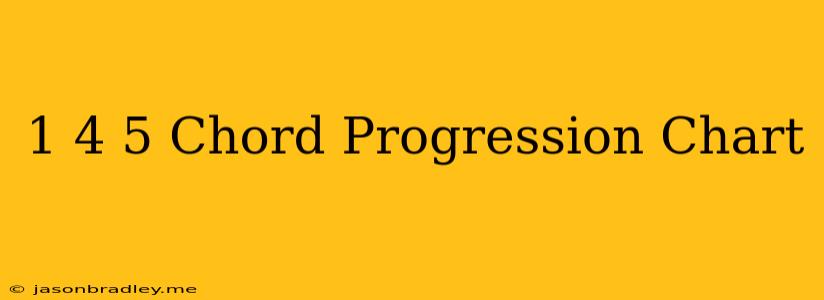The Power of the 1 4 5 Chord Progression: A Beginner's Guide
The 1 4 5 chord progression is a foundational element of music theory, present in countless songs across various genres. It's simple, versatile, and undeniably catchy, making it a go-to for both beginners and seasoned musicians. This article will delve into the 1 4 5 progression, explaining its structure, exploring its uses, and providing practical tips for applying it in your own music.
Understanding the Basics
The 1 4 5 progression is based on the major scale, a seven-note sequence with a specific pattern of whole and half steps. Here's how it breaks down:
- 1 (Root): The first chord in the progression is built on the root note of the scale, forming a major chord. For example, in the key of C major, the first chord is C major.
- 4 (Subdominant): The second chord is built on the fourth note of the scale, forming a major chord. In the key of C major, the fourth chord is F major.
- 5 (Dominant): The third and final chord is built on the fifth note of the scale, forming a major chord. In the key of C major, the fifth chord is G major.
This simple three-chord sequence creates a sense of harmonic movement and resolution, moving from the root chord to the subdominant, creating tension, and finally resolving to the dominant chord, which creates a sense of completion.
The 1 4 5 in Action
The 1 4 5 progression finds its home in countless musical styles:
- Pop: From classic hits like "Twist and Shout" to modern pop anthems, the 1 4 5 progression is a staple.
- Rock: Think of classic rock anthems like "Rock Around the Clock" or "Sweet Home Alabama."
- Country: Many country songs utilize the 1 4 5 progression, giving them a familiar and comforting feel.
- Folk: Traditional folk music often employs this progression, adding a sense of simplicity and authenticity.
Tips for Using the 1 4 5
Here are some tips for using the 1 4 5 progression effectively in your music:
- Experiment with rhythms: While the basic progression can be played in straight eighth or quarter notes, try varying the rhythm for a more interesting feel.
- Add seventh chords: Introduce seventh chords to create a more sophisticated and jazzy feel. Try using the ii (minor seventh), V (dominant seventh), and iii (minor seventh) chords to add color and depth.
- Incorporate inversions: Change the position of the notes within the chords for a different sonic texture.
- Use a capo: Changing the key of a song with a capo can give you a fresh perspective on the 1 4 5 progression.
- Combine it with other progressions: Don't be afraid to incorporate the 1 4 5 into larger chord progressions for a more dynamic sound.
Conclusion
The 1 4 5 chord progression is a powerful tool in any musician's arsenal. Its simplicity allows for creative exploration, while its inherent catchy quality makes it universally appealing. By mastering the 1 4 5 and its variations, you unlock a world of musical possibilities, empowering you to create your own unique and memorable melodies.
